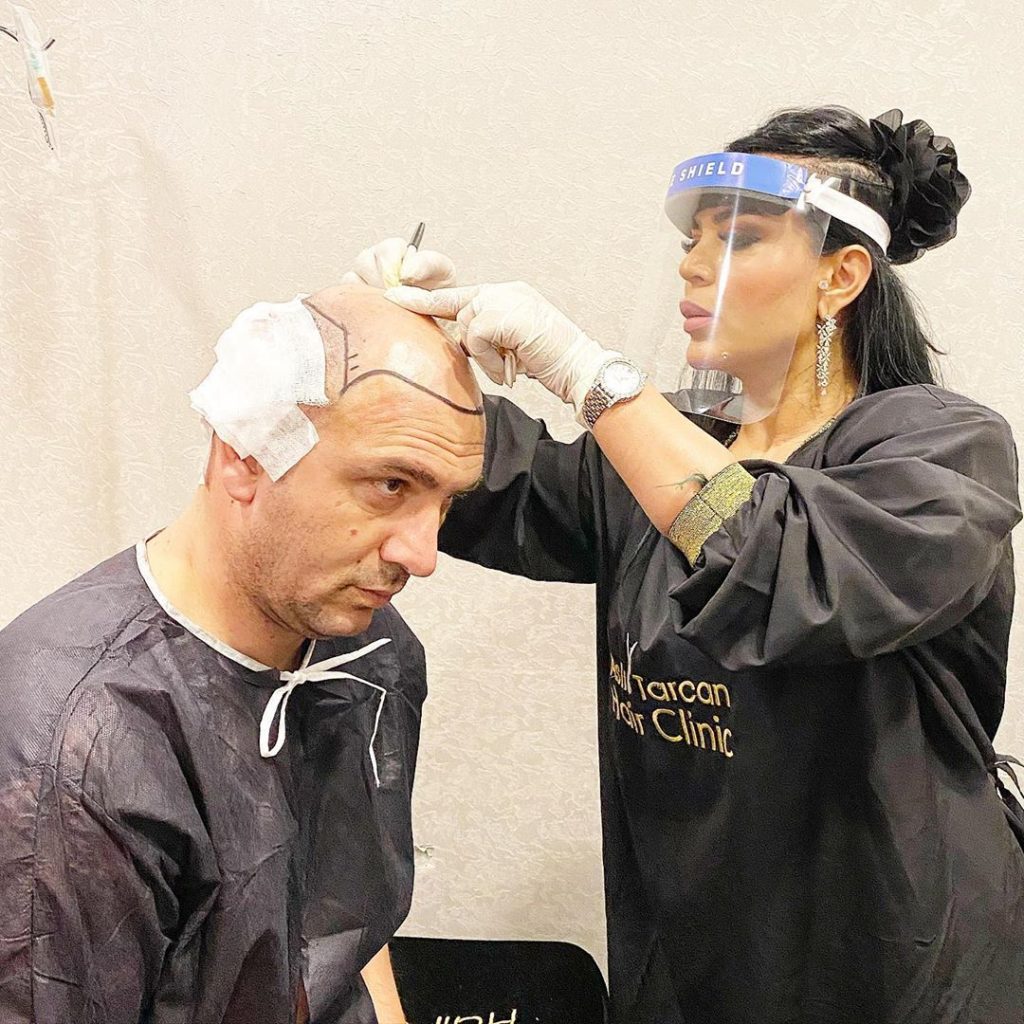
Breast Aesthetics Breasts are an integral part of the body when both their functional and aesthetic features are taken into consideration. But they especially have great importance for women. It is a uniquely important part of the female body and so women who are confident about the appearance of their breasts often have a positive self-image. The development of breasts in women starts during puberty and lasts up to the age of 18 or 19. However, in certain cases such as pregnancy, giving birth, aging, and losing or gaining weight there may occur some changes in the breasts.
For most women, having breasts of adequate size and not hanging are prerequisites for fitting into the beauty standards. Apart from the aesthetic concerns, fat and hanging breasts may cause shoulder-back pain and chronic rash under the breast. As a result of certain hereditary and social factors or some rare diseases, breasts may not be fully developed, they may be bigger than normal or they may not be in the form and shape as a woman desires. Such factors may discomfort people and even lead to some mental health issues such as depression.


As this is the situation, most women turn to breast aesthetics surgery to fix their looking and posture or due to some health-related problems as stated above. The surgery is preferred in such cases as the correction of the hanging breasts, augmentation of small breasts, and breast reconstruction of the lost breast tissue because of cancer. Thanks to breast aesthetics, one can have the breast in any size and shape. They help the patient feel comfortable with her body.
Breast aesthetic surgery can be performed on anyone who is not content with the anatomical structure of her/his breasts as long as they are over 18 years old. The type of breast aesthetic surgery should be decided according to the patient’s request, but when it comes to the size and shape the surgeon has to choose what is best according to the anatomical structure of the patient. In the end, it is an operation that satisfies most of the people who have undergone it both emotionally and physically.
Breast aesthetic surgery has been around and practiced for many years for reduction, enhancement of breasts, and mastopexy so it is not a new practice. In breast aesthetic surgeries, breast reduction is performed by removing excess fat tissue to make the breasts become light and firm. In the field of aesthetic surgery, the number of breast aesthetic surgeries performed since the beginning of the 2000s has exceeded 530 000.
But with the introduction of implants by Cronin and Gerow in 1962, a new dimension has been brought to breast reshaping. A variety of operations such as breast augmentation, breast reduction, gynecomastia, breast lift (mastopexy) are available for patients who are willing to undergo breast aesthetic surgery due to inadequate breast development, breast hypertrophy, developmentally ptotic breasts, weight or age-related changes or to correct breast asymmetry. Breast reduction, reconstruction, mastopexy and augmentation covers for the most common procedure performed today by highly skilled specialists.
However, the use of implant alone has increased significantly in the second half of the last century and breast augmentation for reshaping or remodeling alone has overtaken almost any other aesthetic processes including breast reduction, mastopexy, and reconstruction. The reliability, choice of shape, volume, and positioning of breast implants has provided people who have aesthetic and reconstructive reasons with a range of different options, and predictability. Small volumetric enhancement or asymmetries can be fixed with the help of autologous fat grafting in selected cases. Advancement in imaging techniques has enabled surgeons to provide better breast screening that can delineate suspicious breast lesions following the use of breast implants or autologous fat grafting.
Breast aesthetic surgeries are usually performed under general anesthesia. The patients generally do not need to stay in the hospital after the surgery but in some exceptional cases, 1 night of staying may be recommended by the surgeon. However, in general, the next day after the operation, the patient is discharged and sent home. Most of the patients who have undergone the surgery do not have a complaint about any significant pain-related surgery. Patients can return to their daily routines and lives within 2 or 3 days. By the 10th day after the surgery, all the dressing is removed and patients are completely back to their normal life.
Types Of Breast Aesthetic Surgery
Breast Augmentation
As a result of several factors, breasts may be structurally bigger or smaller. To solve this problem and get rid of the asymmetric look, or simply to increase the volume, breast augmentation surgery is performed. Anyone who has completed their development of breasts and over the age of 18 are eligible for the breast surgery as long as they have no obstacle of health problem for surgery, as is the condition for all kind of surgeries. In general, the surgeons use silicone-based breast prostheses, also called implants, to reshape the breasts. Silicone prostheses may be in different types as to the properties of outer capsules and their sizes and contents.
To determine the type of prosthesis that will be used during the surgery, the patients must first undergo an examination, and also her/his expectations should be taken into consideration. To illustrate, if the prosthesis will be placed to a person who is over 40 years of age, some radiological examinations called mammography and ultrasonography needs to be conducted.
Once the type of prosthesis that will be placed is determined, the breast is augmented by placing prosthesis inserted from the breast lower curve area, nipple perimeter, or armpit to breast tissue or pectoral muscle. If the patients experience sagging in their breasts and if it cannot be fixed with prosthesis alone, breast lifting operation may be applied together with the augmentation. All in all, the breast augmentation procedure is performed to beautify the size and shape of people’s breasts with breast prosthesis in different kinds of types. The duration of the surgery changes between 45 minutes and 2 hours.
During the procedure, general anesthesia is given to the patient. After the operation, most of the patients generally do not need to stay in the hospital but in rare cases, they may be asked to stay overnight. They may back to their daily life and work in about 1 or 3 three days.
Physical contact with breasts is usually recommended after 2 or 3 weeks. And most of the scars will have faded by 2 to 4 months. As with any other surgery, breast augmentation has its own risks. Edema and pain after surgery are common complaints after the surgery. Patients may also feel temporary discomfort, swelling, temporary decrease in sensation of nipple, touch-tenderness in breasts for a couple of weeks. Bleeding and infection are rarely seen cases after the augmentation operation.
Breast Reduction
As a result of some hereditary factors, some diseases, hormonal changes, etc., enlarged breasts that are not compatible with body sizes may develop. Also, such factors as changes in weight, breastfeeding, and gravity may adversely contribute to the existing problem and make it get even worse. Larger breasts than usual may cause great discomfort, especially in women. They may lead to back or neck pain and kyphosis.
Besides, women may experience numbness due to the pressure from bras towards arm nerves. They are likely to experience difficulty in breathing, their physical activity can be restricted and it may even lead to certain mental problems in women. Breast reduction surgery is applied to solve all these problems. Not only does it offer a completely natural appearance but also facilitates the life of a person.
Breast reduction surgery is a reconstructive/reshaping surgery. During the aesthetic operation, excesses skin, fat tissue, and breast tissue are removed, the breast is lifted and the nipple of the breast is moved to where it should be so that the natural fullness look is gained. This reshaping of the larger breast tissue process is done according to the body size of the patient. All in all, breast reduction surgery is performed to remove the excess breast and fat tissue from the inside of the skin and breast from the lower part of the breast, lift and reshape the sagging breasts and nipples.
The duration of the surgery may change between 2.5 to 4 hours. During the procedure, general anesthesia is given to the patient. After the operation, most of the patients generally do not need to stay in the hospital but in rare cases, they may be asked to stay overnight. Patients should use bandage and bra until the healing process is completed in suture areas. They may back to their daily life and work in about 2 weeks of time. Heavy exercises are usually not recommended until 6 weeks.
And most of the scars will have faded by 6-12 months. However, no matter which method is used, a small scar is likely to remain around the nipple. As with any other surgery, breast reduction has its own risks. Potential risks include clarification of scars, infection, skin damages, asymmetry of nipples, numbness on skin. Patients may also feel temporary purpleness, swelling, insensitivity on the skin, temporary dryness, and surgery scars.
Breast reduction procedures are also preferred by men who experience breast growth because of the lack of testosterone hormone in their bodies. This surgery is called gynecomastia.
Breast Reduction In Men (Gynecomastia)
85 % of gynecomastia cases do not result from another disease in the puberty period. Men are likely to experience this problem due to the use of other endocrine-hormonal drugs or drug use. Gynecomastia during the puberty period usually regresses spontaneously, however, some can be permanent. Larger breast tissue in man may lead to some psychological, social, and physical problems in this period such as humpback posture. There may be two types of pathology in breast reduction operation in men.
In the first type, the reason why the breast is enlarged may result from fat tissue in that area. In such cases, it is possible to solve the problem by turning to the liposuction method. While in the second type, this problem may depend on excess breast tissue. In such situations, excess breast tissue is surgically removed. The result gained from gynecomastia surgery is mostly permanent and repeated enlargement does not occur.
All in all, breast reduction surgery in men, also known as gynecomastia, is performed to remove enlarged breast tissue by accessing from nipple end or removing fats with liposuction. The duration of the surgery may change between 1 to 2 hours. During the procedure, general or local anesthesia supported with sedation can be given to the patient.
After the operation, most of the patients generally do not need to stay in the hospital but in rare cases, they may be asked to stay overnight. Patients should use bandage and bra until the healing process is completed in suture areas. They may back to their daily life and work in about 2 weeks of time. Heavy exercises are usually not recommended until 6 weeks. And most of the scars will have faded by 3 to 6 months. As with any other surgery, breast reduction has its own risks. Gynecomastia is a critical operation in terms of its potential causes. Those potential risks may include clarification of scars, infection, skin damages, asymmetry of nipples, numbness on skin. Patients may also feel temporary purpleness, swelling, insensitivity on the skin, temporary dryness, and surgery scars.
Breast Lift (Mastopexy)
Bonds that hold the breast tissue in place may start to get loose in the course of time. Also, in such occurrences as gaining or losing weight and breastfeeding inconsistency may occur between skin envelopes that are wrapped with breast tissue. Breast sagging is a common occurrence that most of the women experience. However, this problem is generally seen in full-breasted women but other women with normal breast sizes may also experience this problem. If you experience the same problem and make your breasts look more lifted, you may consider getting a breast lift, or in its other name mastopexy, operation. In breast lift operation, also known as mastopexy, the method is relatively different than that of the breast reduction surgery.
While excess breast tissue is removed in breast reduction surgery, sagging in the breast can be planned in a way to fix the hanging breast. Thanks to the breast lift operation women can avoid sagging, losing firmness and skin elasticity, a flatter or elongated breast, a nipple, and areola that point downwards, having stretched skin and an enlarged areola, nipples that fall below the breast crease if unsupported, etc. In women with normal breast size but with the presence of sagging, breast tissue is not needed to be removed.
Only excess tissue is removed and the nipple is taken to its normal place and by doing so, a fixing procedure is performed. In case of deficiency of existing breast tissue, it may be needed to place prosthesis inside the breast while sagging is being corrected. All in all, breast lift surgery, also known as mastopexy, is performed to lift and reconstruct the sagging breasts and nipples. The duration of the surgery may change between 2 to 3 hours. During the procedure, general or local anesthesia supported with sedation can be given to the patient in very restricted interventions.
After the operation, most of the patients generally do not need to stay in the hospital but in rare cases, they may be asked to stay overnight. Patients should use bandage and bra until the healing process is completed in suture areas. They may back to their daily life and work in about 1 or 2 weeks of time. Heavy exercises are usually not recommended until 1 month. And most of the scars will have faded by 3 to 6 months. As with any other surgery, breast lift has its own risks. Some potential risks may include clarification of scars, infection, skin damages, asymmetry of nipples, numbness on skin. Patients may also feel temporary purpleness, swelling, insensitivity on the skin, temporary dryness, and surgery scars.
Is There Any Loss Of Sensation?
The loss of sensation after breast aesthetic surgeries may differ greatly from person to person. However, most of the patients who have undergone the operation say that they have not experienced such a problem and so they do not have any complaints about it. It is possible to say that it is a rarely seen problem. Especially in breast augmentation procedure, the nipple is not affected so the loss of sensation is not experienced since they are performed under the breast. In addition to these, what type of surgical technique in breast reduction will be used is quite an important factor regarding the potential loss of sensation in the nipple.
By making use of suitable techniques according to your body sizes, preserving the place of the nerves located in the nipple, and paying great attention to them during the surgery, there will surely be no change in the sensitivity of the nipple. Especially in breast reduction surgeries, larger breasts than usual may carry a risk of decreased nipple sensation. It is also observed that nipple sensation is experienced less in patients with large breasts. However, the sensation may improve in certain patients when their breasts are reduced.
Do The Operation Prevent Breastfeeding?
Breast aesthetic surgeries, especially breast augmentation do not possess any potential harm again pregnancy and breastfeeding. For instance, there are some patients who have undergone breast augmentation right after they have given birth and they have experienced no problem in breastfeeding or giving birth again. On the contrary, it is pretty easy to feed the baby after the operation.
Furthermore, in breast reduction operations, breastfeeding of the patient differs in line with the protection of the patient’s mammary ducts. Mammary ducts come out of the breast and come into the nipple as a group and milk can flow out of the nipple with this group without any interruption while coming to the nipple. So, the ability to breastfeed is not affected thanks to the preservation of mammary ducts in the process. The techniques used during the process are completely safe and they are designed to protect the mammary ducts.
How Are The Prices Determined?
The factors that determine the prices of breast aesthetic operations may differ depending on several reasons such as how famous and good is the hospital, where the surgery will take place, how good are the materials used in the surgery, how much does the silicon cost -which is going to be used in the surgery if breast augmentation procedure is carried out-, whether or not the silicone is the product of a good company and can be used for life. etc. The use of trusted quality silicones will minimize silicone-related complications and can be used safely for a lifetime. However, among them, especially the choice of a good hospital plays a vital role in gaining the best results from breast aesthetic operations as performing surgery in distinguished hospitals will bring less post-operative complications.
When Does The Patients Return To Their Daily Life After Breast Aesthetic Surgery?
Breast aesthetic surgeries can be divided into 2 main categories as breast reduction and breast augmentation. In both operations, patients usually return to their daily life and work in 3 or 4 days. However, it is possible to say that breast reduction surgeries offer less pain and so are easier and quicker for patients to recover from. In breast augmentation surgeries, a more compressing feeling is likely to happen but it is something that can dwindle in 7 to 10 days.
Nevertheless, breast aesthetic surgeries are not quite painful operations because the breast is an external organ and so it does not have vital vessels or nerves and also has no tissue to sense the pain critically. Therefore, you should not be afraid of undergoing breast aesthetic surgery. If you are considering having it, all you need to do is to have a good hospital and a skilled doctor. Attractive, natural-looking results are possible when you choose an aesthetic plastic surgeon who has proper training, sufficient experience, and an artistic approach.


